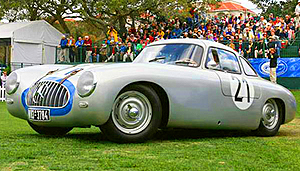
Legendary race cars such as this 1955 Mercedes 300SLR are engineered with zero excess weight to maximize performance. (Photo credit: L. Salomao)
When considering three elements of performance: speed, handling and economy – vehicle weight impacts all of them. That’s why racehorses are lean and jockeys are diminutive. Every race car engineer knows that weight is the single most important factor in establishing performance. Legendary competition cars which set racetracks afire over the decades have had every spare ounce paired off and were constructed of exotic light weight alloys. Weight counts.
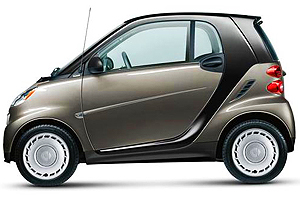
The Smart 2-seat coupe weighs just over 1,800 pounds, and is less than 9 feet long – half the length of a Ford Crown Vic sedan. EPA fuel economy is rated at 34/38. (Photo credit: Smart.com)
There are two intriguing vehicles on the market today with monikers signifying they are “intelligent”, or “bright”. The first one boasts a maximum carrying capacity of 500 pounds, top speed of 90 miles per hour, curb weight of 1,800 pounds, and 34 city / 38 highway mpg rating using premium fuel. The whole car is just under 8 feet long and has two seats. The second one is larger, stretching to 10 feet with what has to be the world’s smallest rear seat. Its curb weight is just over 2,100 pounds and rates 36 city / 37 highway on the EPA mileage tests.
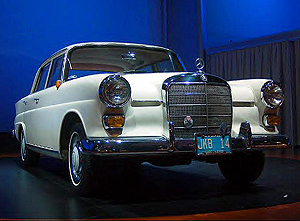
The ’65 Mercedes 190D 4-cylinder diesel seats five, has 22 cubic feet of trunk space, and can get up to 47 miles per gallon under highway conditions. Something most of today’s economy cars cannot claim. (Photo credit: J. Bleimaier)
I own a 1965 Mercedes 190Dc sedan (Diesel) which has been in our family since new. Of course she has had a name since day one. But recently we have begun to call her, “The Genius.” That’s because of the 190Dc’s phenomenal performance. The Genius is capable of posting respectable times on give-and-take byways. Her road holding is on a par with sports cars of her day. AND, she delivers 37 miles per gallon of Diesel fuel.
Once in an “economy run” road rallye in 1991 we managed to eke out 47 miles per gallon, coasting down hills in neutral and radically limiting engine rpm. The 190Dc seats five adults and has a 22 cubic foot trunk capacity. Compared to the intelligent contemporary microcars my 1965 Diesel really is a genius.
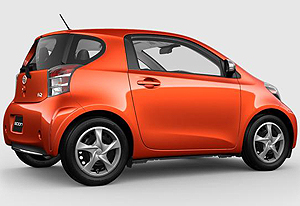
Scion’s recently introduced iQ model is 10 feet long, seats 4, and has a 36/37 mpg rating.
But, in the final analysis, there is no real mystery about automotive intelligence. The key to impressive performance is always weight. Despite its ample dimensions, the Mercedes 190Dc tips the scales at just over 2700 pounds. That’s for a five passenger saloon with capacious trunk, on a 106 inch wheelbase, powered by a 1998cc displacement com-pression ignition engine. On the other hand, the 2012 intelligent vehicles are just chubby nerds. For their size, today’s bright lads are way too heavy. Consequently the lack luster fuel economy.
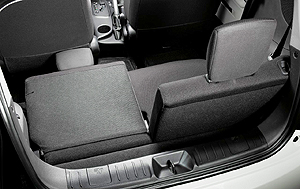
The Scion iQ’s rear seat is suitable for small children only. Seatbacks must be folded down in order to use trunk space. (Photo credit: D. Myers)
I’m certainly not knocking the 21st Century intelligent car concepts. There is clearly a need for urban vehicles with a small physical footprint. But I would suggest that substantial weight savings, and exploration of Diesel technology, might render such a vehicle a truly stellar performer and an efficiency champ.
In the meantime, I happily get behind the wheel of my 1965 Mercedes-Benz Diesel on a spring weekend and enjoy the fruits of an earlier technology as I drive out to my favorite dining establishment. And, in the spirit of practicing what I preach, I am ordering a Caesar salad.
 -John
-John
(Contributor John Bleimaier is an attorney at law, active Mercedes-Benz club officer, and automotive journalist for The Star magazine.)
 1969 Volkswagen Karmann Ghia wheelPhoto: Genna Rae
1969 Volkswagen Karmann Ghia wheelPhoto: Genna Rae 1969 Volkswagen Karmann GhiaPhoto: Genna Rae
1969 Volkswagen Karmann GhiaPhoto: Genna Rae 50s Calnevar aftermarket hubcaps shPhoto credit: T. Gorski
50s Calnevar aftermarket hubcaps shPhoto credit: T. Gorski Chrysler LeBaron Town & Country wheel cover
Chrysler LeBaron Town & Country wheel cover Cadillac Eldorado painted wheel cover 1976-78Photo: Nate Smith
Cadillac Eldorado painted wheel cover 1976-78Photo: Nate Smith 1974 - 1976 Lincoln Continental wheel coverPhoto credit: H. Carver
1974 - 1976 Lincoln Continental wheel coverPhoto credit: H. Carver 1969 Oldsmobile Cutlass Supreme rallye wheelPhoto: C. DeMarco
1969 Oldsmobile Cutlass Supreme rallye wheelPhoto: C. DeMarco Chrysler 1980s painted wheel coverPhoto: O. Stein
Chrysler 1980s painted wheel coverPhoto: O. Stein 13-inch General Motors color matched wheel 1975-80Photo: Valley Ride Styles
13-inch General Motors color matched wheel 1975-80Photo: Valley Ride Styles Audi TT RS wheelPhoto: Sean Connor
Audi TT RS wheelPhoto: Sean Connor 1994 - 1995 Mercedes E320 Cabriolet wheel
1994 - 1995 Mercedes E320 Cabriolet wheel 2012 Volkswagen Beetle 2.5 standard wheel
2012 Volkswagen Beetle 2.5 standard wheel 16-inch black steel Land Rover off-road wheelsPhoto credit: J. Getty
16-inch black steel Land Rover off-road wheelsPhoto credit: J. Getty 18-inch aluminum wheel on 2003 - 2004 Land Rover Discovery HSE
18-inch aluminum wheel on 2003 - 2004 Land Rover Discovery HSE 18 inch "Hurricane" aluminum wheel standard on 2002-2004 Discovery SE
18 inch "Hurricane" aluminum wheel standard on 2002-2004 Discovery SE 1957 - 1958 Pontiac wire wheel cover(Photo credit: R. Ulrich)
1957 - 1958 Pontiac wire wheel cover(Photo credit: R. Ulrich) 1972 Mercedes 280SE 4.5 equipped with repro 15-inch alloy wheels(Photo credit: Sean Connor)
1972 Mercedes 280SE 4.5 equipped with repro 15-inch alloy wheels(Photo credit: Sean Connor) 560SL 15-inch aluminum wheel
560SL 15-inch aluminum wheel 1981 Porsche 924 Carrera GT aluminum wheel
1981 Porsche 924 Carrera GT aluminum wheel 1978 Lincoln Mark V DJ blue wheel b(Photo credit: M. Garrett)
1978 Lincoln Mark V DJ blue wheel b(Photo credit: M. Garrett) 1979 Lincoln Mark V Collectors Series navy blue painted wheel(Photo credit: M. Garrett)
1979 Lincoln Mark V Collectors Series navy blue painted wheel(Photo credit: M. Garrett) 1969 Dodge Charger RT Hemi wheel with center hub cap
1969 Dodge Charger RT Hemi wheel with center hub cap 1953 Oldsmobile wire-wheel
1953 Oldsmobile wire-wheel 2014 Jaguar XK RS GT wheel at the 2013 New York Auto Show(Photo credit: Sean Connor)
2014 Jaguar XK RS GT wheel at the 2013 New York Auto Show(Photo credit: Sean Connor) 2014 Mercedes CLA45 AMG wheel at the 2013 New York Auto Show(Photo credit: Sean Connor)
2014 Mercedes CLA45 AMG wheel at the 2013 New York Auto Show(Photo credit: Sean Connor) 2013 Subaru WRX concept wheel at the 2013 New York Auto Show
2013 Subaru WRX concept wheel at the 2013 New York Auto Show 1952 Volkswagen wheelPhoto credit: L. Jacobs
1952 Volkswagen wheelPhoto credit: L. Jacobs 1975 Pontiac Grand Ville rallye wheelPhoto credit: Sean Connor
1975 Pontiac Grand Ville rallye wheelPhoto credit: Sean Connor 1991 Cadillac Fleetwood Brougham wire wheel cover
1991 Cadillac Fleetwood Brougham wire wheel cover Dodge Charger all-black police car wheel a
Dodge Charger all-black police car wheel a Dodge Charger all-black police car wheel b
Dodge Charger all-black police car wheel b 1963 Mercedes 230SL wheel at the 2013 June Jamboree in Montvale, NJPhoto: Sean Connor
1963 Mercedes 230SL wheel at the 2013 June Jamboree in Montvale, NJPhoto: Sean Connor 1964 Mercedes 230SL wheel at the 2013 Mercedes-Benz June JamboreePhoto: Kristi Burns
1964 Mercedes 230SL wheel at the 2013 Mercedes-Benz June JamboreePhoto: Kristi Burns
When all is said and done, a ’65 Mercedes diesel has a higher automotive Intelligence Quotient than several of today’s microcars.
Legendary race cars such as this 1955 Mercedes 300SLR are engineered with zero excess weight to maximize performance. (Photo credit: L. Salomao)
When considering three elements of performance: speed, handling and economy – vehicle weight impacts all of them. That’s why racehorses are lean and jockeys are diminutive. Every race car engineer knows that weight is the single most important factor in establishing performance. Legendary competition cars which set racetracks afire over the decades have had every spare ounce paired off and were constructed of exotic light weight alloys. Weight counts.
The Smart 2-seat coupe weighs just over 1,800 pounds, and is less than 9 feet long – half the length of a Ford Crown Vic sedan. EPA fuel economy is rated at 34/38. (Photo credit: Smart.com)
There are two intriguing vehicles on the market today with monikers signifying they are “intelligent”, or “bright”. The first one boasts a maximum carrying capacity of 500 pounds, top speed of 90 miles per hour, curb weight of 1,800 pounds, and 34 city / 38 highway mpg rating using premium fuel. The whole car is just under 8 feet long and has two seats. The second one is larger, stretching to 10 feet with what has to be the world’s smallest rear seat. Its curb weight is just over 2,100 pounds and rates 36 city / 37 highway on the EPA mileage tests.
The ’65 Mercedes 190D 4-cylinder diesel seats five, has 22 cubic feet of trunk space, and can get up to 47 miles per gallon under highway conditions. Something most of today’s economy cars cannot claim. (Photo credit: J. Bleimaier)
I own a 1965 Mercedes 190Dc sedan (Diesel) which has been in our family since new. Of course she has had a name since day one. But recently we have begun to call her, “The Genius.” That’s because of the 190Dc’s phenomenal performance. The Genius is capable of posting respectable times on give-and-take byways. Her road holding is on a par with sports cars of her day. AND, she delivers 37 miles per gallon of Diesel fuel.
Once in an “economy run” road rallye in 1991 we managed to eke out 47 miles per gallon, coasting down hills in neutral and radically limiting engine rpm. The 190Dc seats five adults and has a 22 cubic foot trunk capacity. Compared to the intelligent contemporary microcars my 1965 Diesel really is a genius.
Scion’s recently introduced iQ model is 10 feet long, seats 4, and has a 36/37 mpg rating.
But, in the final analysis, there is no real mystery about automotive intelligence. The key to impressive performance is always weight. Despite its ample dimensions, the Mercedes 190Dc tips the scales at just over 2700 pounds. That’s for a five passenger saloon with capacious trunk, on a 106 inch wheelbase, powered by a 1998cc displacement com-pression ignition engine. On the other hand, the 2012 intelligent vehicles are just chubby nerds. For their size, today’s bright lads are way too heavy. Consequently the lack luster fuel economy.
The Scion iQ’s rear seat is suitable for small children only. Seatbacks must be folded down in order to use trunk space. (Photo credit: D. Myers)
I’m certainly not knocking the 21st Century intelligent car concepts. There is clearly a need for urban vehicles with a small physical footprint. But I would suggest that substantial weight savings, and exploration of Diesel technology, might render such a vehicle a truly stellar performer and an efficiency champ.
In the meantime, I happily get behind the wheel of my 1965 Mercedes-Benz Diesel on a spring weekend and enjoy the fruits of an earlier technology as I drive out to my favorite dining establishment. And, in the spirit of practicing what I preach, I am ordering a Caesar salad.
(Contributor John Bleimaier is an attorney at law, active Mercedes-Benz club officer, and automotive journalist for The Star magazine.)